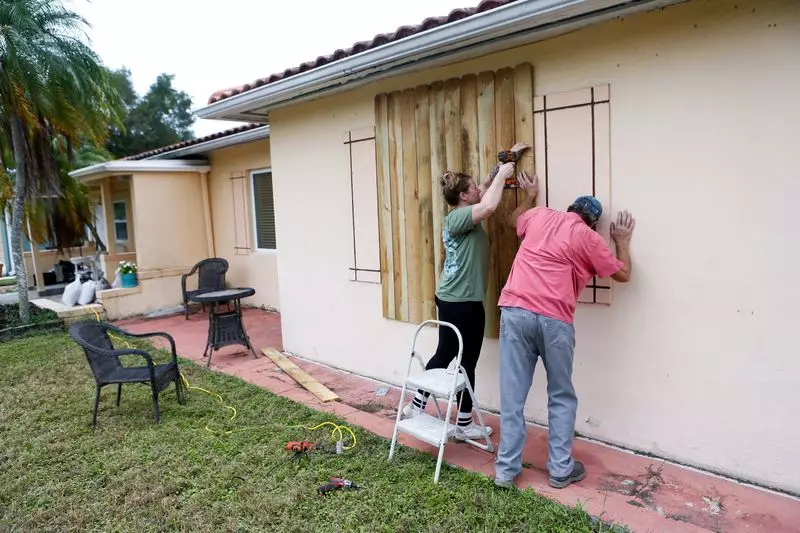The state of Florida is grappling with a critical moment in its property insurance landscape as Hurricane Milton looms—a force that not only endangers lives and property but also threatens to exacerbate an already precarious insurance market. The challenges posed by Milton could lead to skyrocketing insurance premiums and limited coverage options in a region already notorious for the highest insurance costs in the United States.
Recent estimates forecast that Hurricane Milton could entail between $60 billion and $100 billion in insured losses, indicating the overwhelming financial burden it may impose on an industry that has already been strained to its limits. The storm is projected to make landfall near Tampa Bay, a region home to over three million residents, many still reeling from the aftermath of Hurricane Helene just weeks prior. This precarious situation reflects an alarming trend characterized by a cycle of escalating risks and diminishing support from national insurance firms.
The mere presence of a hurricane with maximum winds of up to 160 mph raises pressing concerns among industry analysts and local homeowners alike. Martin Weiss, founder of Weiss Ratings, lamented the fundamental principles of insurance that should protect consumers but instead seem inadequate amidst such recurrent threats. Floridians are left in a precarious position, relying on an underfunded market that often fails to meet their needs effectively.
The implications of these storms extend beyond immediate damages; they indicate a broader problem in Florida’s insurance market. With 2021 marking a peak in population growth in Florida, the paradox remains that this increased demand for housing coexists with a deteriorating insurance infrastructure. Statistics reveal that 78 of the 80 highest-risk ZIP codes in the country are located in Florida, leaving the state exposed to compounded hazards from extreme weather events and rising sea levels.
The exodus of major insurance providers following catastrophic events, such as Hurricane Andrew in 1992, has led to a landscape dominated by smaller companies with limited resources. Since 2003, 41 Florida insurers have failed, a stark contrast to the rest of the nation where only 37 have met a similar fate. Moreover, even those companies that remain active in the market tend to be reticent, with recent data indicating that nearly half of all claims filed with some of the largest providers in Florida were rejected in 2023.
To address this growing crisis, the state created Citizens Property Insurance Corporation in 2002, designed to assist homeowners unable to find coverage elsewhere. This quasi-public entity has become the largest insurer in Florida, offering policies to over 1.2 million households. While Citizens has the unique ability to charge surcharges to cover claims—ensuring some level of payout—this safety net is not without its drawbacks. The potential for policyholders to face an additional financial burden should the insurer run out of funds raises alarms about long-term sustainability.
At this juncture, average insurance costs for homeowners in Florida already exceed $4,060 annually, far above the national average, and these figures do not account for separate flood insurance policies. Consequently, consumers are caught in a bind: while insurance is essential, the increasing costs have forced many to reconsider their coverage options, often opting to forego protection entirely. This pattern is particularly concerning for the underserved segments of the population who are disproportionately affected by these rising costs.
Despite the tumultuous insurance landscape and the threat posed by Hurricane Milton, some industry insiders remain optimistic about Florida’s real estate market. While it is undeniable that rates may continue to increase and that some insurers may face bankruptcy, the appeal of Florida as a desirable destination has not dimmed. Real estate prices have continued an upward trajectory, indicating a resilient demand that persists even in the face of natural disasters.
Experts caution, however, that this optimism may be fleeting if storms like Milton begin to inflict similar damage as historical catastrophes like Hurricane Katrina did in 2005. As homeowners wrestle with the decision to either increase their coverage or risk going uninsured, the impending storm serves as a grim reminder of the fragility of Florida’s insurance market. The potential economic repercussions could usher in a new wave of challenges for the state, discouraging new residents just as existing homeowners seek stability amid uncertainty.
Hurricane Milton stands to amplify existing threats in Florida’s already precarious property insurance climate. The coming weeks will undoubtedly showcase the fragility of the system and the urgent need for sustainable solutions as Florida grapples with the double-edged sword of natural beauty and environmental risk.

